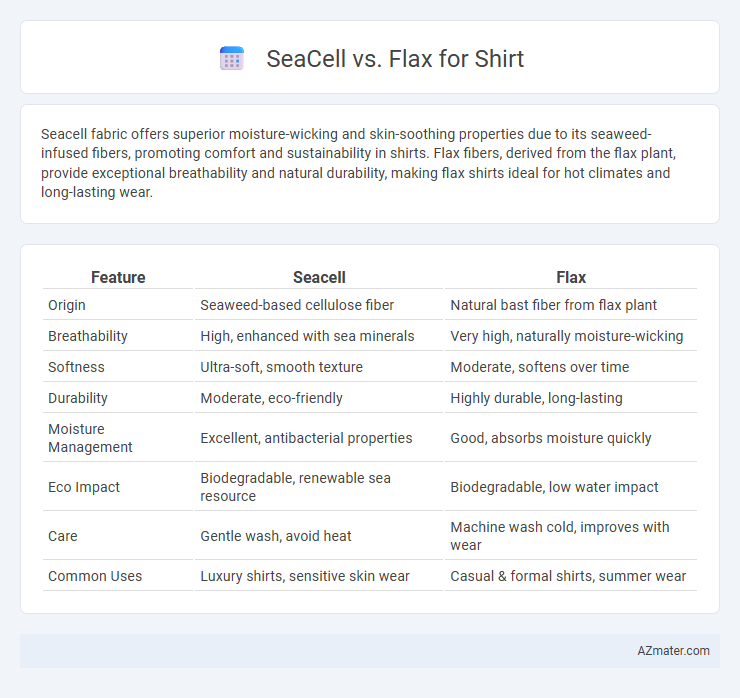Seacell fabric offers superior moisture-wicking and skin-soothing properties due to its seaweed-infused fibers, promoting comfort and sustainability in shirts. Flax fibers, derived from the flax plant, provide exceptional breathability and natural durability, making flax shirts ideal for hot climates and long-lasting wear.
Table of Comparison
| Feature | Seacell | Flax |
|---|---|---|
| Origin | Seaweed-based cellulose fiber | Natural bast fiber from flax plant |
| Breathability | High, enhanced with sea minerals | Very high, naturally moisture-wicking |
| Softness | Ultra-soft, smooth texture | Moderate, softens over time |
| Durability | Moderate, eco-friendly | Highly durable, long-lasting |
| Moisture Management | Excellent, antibacterial properties | Good, absorbs moisture quickly |
| Eco Impact | Biodegradable, renewable sea resource | Biodegradable, low water impact |
| Care | Gentle wash, avoid heat | Machine wash cold, improves with wear |
| Common Uses | Luxury shirts, sensitive skin wear | Casual & formal shirts, summer wear |
Introduction to Seacell and Flax Fabrics
Seacell fabric is a cellulose fiber infused with seaweed extract, known for its skin-friendly properties and biodegradability, making it an innovative choice for sustainable clothing such as shirts. Flax fabric, derived from the flax plant, is renowned for its durability, breathability, and natural luster, often used in linen textiles ideal for warm weather garments. Both Seacell and flax offer eco-friendly alternatives with unique textures and benefits, appealing to consumers seeking comfort and sustainability in their shirts.
Origin and Production Process
Seacell fabric is derived from sustainable seaweed blended with organic cotton, where sea algae are harvested, cleaned, and spun into fiber using eco-friendly methods that retain natural minerals beneficial for the skin. Flax, sourced from the flax plant cultivated primarily in Europe, undergoes a retting process to separate fibers before being spun into linen, known for its durability and breathability. Both materials emphasize natural origins but differ significantly in their fiber extraction and manufacturing processes, influencing the texture and performance of shirts made from each.
Sustainability and Environmental Impact
Seacell, derived from seaweed and cellulose fibers, offers superior sustainability due to its renewable marine resources and biodegradability, which reduce environmental impact compared to flax, whose cultivation requires significant land and water usage. Flax, while biodegradable and naturally sourced, involves intensive agricultural inputs like pesticides and fertilizers that can contribute to soil degradation and water pollution. Choosing Seacell for shirts supports marine ecosystem conservation and lowers carbon footprint through its eco-friendly fiber production process.
Texture and Comfort Comparison
Seacell fabric offers a silky-smooth texture with natural moisture-wicking properties, providing enhanced breathability and softness ideal for sensitive skin. Flax, derived from flax fibers in linen, delivers a crisp, slightly coarse texture that softens over time and excels in durability and moisture absorption. Preference for Seacell or Flax shirts depends on whether one prioritizes immediate softness and skin benefits or a traditional, breathable fabric that becomes more comfortable with wear.
Breathability and Moisture Management
Seacell fabric, infused with seaweed fibers, offers superior moisture management by naturally wicking sweat and providing antibacterial properties that enhance breathability for shirts. Flax, derived from flax stems, promotes exceptional airflow through its coarse, breathable texture, making it ideal for hot climates but may lack the same moisture-wicking efficiency as Seacell. Shirts made from Seacell blend outperfom pure flax by combining comfort with advanced moisture regulation, crucial for active or humid environments.
Durability and Longevity
Seacell shirts offer enhanced durability due to their blend of seaweed fibers and high-quality cotton, providing resistance to wear and tear while maintaining softness. Flax-based linen shirts are known for their strength and long lifespan, with natural fibers that become softer yet more resilient after multiple washes. Both materials ensure longevity, but Seacell combines sustainable performance with added skin benefits, whereas flax emphasizes traditional durability and breathability.
Skin Benefits and Sensitivity
Seacell fabric, infused with seaweed extracts, offers natural antioxidants and minerals that promote skin hydration and reduce inflammation, making it ideal for sensitive skin. Flax, derived from flaxseed fibers, provides breathable, moisture-wicking properties that soothe irritation and support skin healing through omega-3 fatty acids. Shirts made from Seacell excel in enhancing skin regeneration, while flax fibers focus on maintaining skin comfort and minimizing allergic reactions.
Aesthetic and Style Options
Seacell fabric offers a sleek, smooth texture with a subtle sheen that enhances the modern and luxurious aesthetic of shirts, making them ideal for stylish, upscale looks. Flax, derived from linen, provides a natural, slightly textured appearance with a matte finish, perfect for casual, breathable, and effortlessly chic summer shirts. Seacell shirts often feature rich, vibrant colors with a refined drape, while flax presents earthy tones and relaxed silhouettes suited for a laid-back, organic style.
Cost and Accessibility
Seacell shirts are typically more expensive due to the advanced seaweed fiber technology and limited production scale, whereas flax shirts, made from linen, offer a more affordable option with widespread availability. Flax fibers are extensively cultivated in regions like Europe and North America, making linen shirts accessible in most markets. Cost-effectiveness and ease of sourcing make flax a preferred choice, while Seacell provides unique functional benefits at a premium price point.
Which is Better for Shirts: Seacell or Flax?
Seacell fabric, infused with algae fibers, offers natural moisture-wicking and antibacterial properties, making it ideal for comfortable, odor-resistant shirts. Flax, derived from flax fibers, is highly breathable and durable, providing excellent temperature regulation and eco-friendly benefits. For shirts, Seacell is better suited for active wear and skin-sensitive users, while Flax excels in classic, lightweight, and breathable summer shirts.

Infographic: Seacell vs Flax for Shirt
 azmater.com
azmater.com